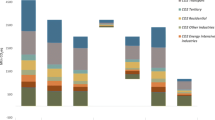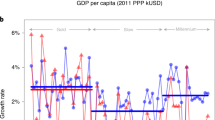Abstract
This paper examines the macroeconomic rebound effect for the global economy arising from energy-efficiency policies. Such policies are expected to be a leading component of climate policy portfolios being proposed and adopted in order to achieve climate stabilisation targets for 2020, 2030 and 2050, such as the G8 50% reduction target by 2050. We apply the global “New Economics” or Post Keynesian model E3MG, developing the version reported in IPCC AR4 WG3. The rebound effect refers to the idea that some or all of the expected reductions in energy consumption as a result of energy-efficiency improvements are offset by an increasing demand for energy services, arising from reductions in the effective price of energy services resulting from those improvements. As policies to stimulate energy-efficiency improvements are a key part of climate-change policies, the likely magnitude of any rebound effect is of great importance to assessing the effectiveness of those policies. The literature distinguishes three types of rebound effect from energy-efficiency improvements: direct, indirect and economy-wide. The macroeconomic rebound effect, which is the focus of this paper, is the combination of the indirect and economy-wide effects. Estimates of the effects of no-regrets efficiency policies are reported by the International Energy Agency in World Energy Outlook, 2006, and synthesised in the IPCC AR4 WG3 report. We analyse policies for the transport, residential and services buildings and industrial sectors of the economy for the post-2012 period, 2013–2030. The estimated direct rebound effect, implicit in the IEA WEO/IPCC AR4 estimates, is treated as exogenous, based on estimates from the literature, globally about 10%. The total rebound effect, however, is 31% by 2020 rising to 52% by 2030. The total effect includes the direct effect and the effects of (1) the lower cost of energy on energy demand in the three broad sectors as well as of (2) the extra consumers’ expenditure from higher (implicit) real income and (3) the extra energy-efficiency investments. The rebound effects build up over time as the economic system adapts to the higher real incomes from the energy savings and the investments.


Similar content being viewed by others
Notes
This is in contrast to the mainstream equilibrium approach (see DeCanio, 2003 for a critique) adopted in most economic models of climate stabilisation costs. See (Weyant, 2004) for a discussion of technological change in this approach. Setterfield (1997) explicitly compares the approaches in modelling growth and Barker et al. (2006) compares them in modelling mitigation.
The theoretical basis of the approach is that economic growth is demand-led and supply constrained. Growth is seen as a macroeconomic phenomenon arising out of increasing returns (Young, 1928), which engender technological change and diffusion, and which proceeds unevenly and indefinitely unless checked by imbalances. Clearly growth can increase only if labour and other resources in the world economy can be utilised in more productive ways, e.g. with new technologies and/or if they are otherwise underemployed in subsistence agriculture or unemployed. Palley (2003) discusses how long-run supply is affected by actual growth. In contrast, the modern theory of supply-side economic growth assumes full employment and representative agents, and optimises an intergenerational social welfare function (see Aghion and Howitt, 1998). It goes back to Solow (1956, 1957), with endogenous growth theory developed by Romer (1986, 1990).
References
Aghion, P., & Howitt, P. (1998). Endogenous Growth Theory. Cambridge: MIT.
ADAM D-M2.1. (2007). Portfolio of policy and technological options for P3a case study.
Anderson, D., & Winne, S. (2004). 'Modelling innovation and threshold effects in climate change mitigation', Working Paper No. 59, Tyndall Centre for Climate Change Research. www.tyndall.ac.uk/publications/pub_list_2004.shtml.
Barker, T. (2008). ‘The economics of dangerous climate change”. Editorial for the Special Issue of Climatic Change on “The Stern Review and its Critics”. Climatic Change, 89, 173–194. doi:10.1007/s10584-008-9433-x.
Barker, T. S., Ekins, P., & Johnstone, N. (1995). Global Warming and Energy Demand. London: Routledge.
Barker, T., Pan, H., Köhler, J., Warren, R., & Winne, S. (2006). Decarbonizing the Global Economy with Induced Technological Change: Scenarios to 2100 using E3MG. In O. Edenhofer, K. Lessmann, K. Kemfert, M. Grubb, & J. Köhler (Eds.), Induced Technological Change: Exploring its Implications for the Economics of Atmospheric Stabilization Energy Journal Special Issue on the International Model Comparison Project.
Barker, T., Ekins, P., & Foxon, T. (2007). The macroeconomic rebound effect and the UK economy. Energy Policy, 35, 4935–4946. doi:10.1016/j.enpol.2007.04.009.
Bentzen, J., & Engsted, T. (1993). Short- and long-run elasticities in energy demand: a cointegration approach. Energy Economics, 15(1), 9–16. doi:10.1016/0140-9883(93)90037-R.
BERR ER (2006). Energy review. Overarching initial regulatory impact assessment, Department for Business & Regulatory Reform, http://www.berr.gov.uk/files/file32177.pdf.
BERR EWP (2007). Meeting the energy challenge. A white paper on energy, Department for Business & Regulatory Reform, http://www.berr.gov.uk/files/file39387.pdf.
Brookes, L. (1990). The Greenhouse Effect: Fallacies in the energy efficiency solution. Energy Policy, 18, 199–201. doi:10.1016/0301-4215(90)90145-T.
DeCanio, S. (2003). Economic Models of Climate Change: A Critique. New York: Palgrave-Macmillan.
Dimitropoulos, J. (2007). Energy productivity improvements and the rebound effect: An overview of the state of knowledge. Energy Policy, 35, 6354–6363. doi:10.1016/j.enpol.2007.07.028.
Franzén, M., & Sterner, T. (1995). Long-run Demand Elasticities for Gasoline. In T. Barker, N. Johnstone & P. Ekins (Eds.), Global Warming and Energy Elasticities. London: Routledge.
Geller, H., Harrington, P., Rosenfeld, A. H., Tanishimad, S., & Unander, F. (2006). Polices for increasing energy efficiency: Thirty years of experience in OECD countries. Energy Policy, 34, 556–573. doi:10.1016/j.enpol.2005.11.010.
Greening, L., Greene, D. L., & Difiglio, C. (2000). Energy Efficiency and Consumption - The Rebound Effect - A Survey. Energy Policy, 28, 389–401. doi:10.1016/S0301-4215(00)00021-5.
Grepperud, S., & Rasmussen, I. (2004). A general equilibrium assessment of rebound effects. Energy Economics, 26, 261–282. doi:10.1016/j.eneco.2003.11.003.
Grubb, M. (1990). Energy efficiency and economic fallacies. Energy Policy, 18, 783–785. doi:10.1016/0301-4215(90)90031-x.
Herring, H. (2004). The rebound effect and energy conservation. In C. Cleveland (Ed.), The Encyclopedia of Energy. Academic Press/Elsevier Science.
Herring, H., & Sorrell, S. (2009). Energy efficiency and sustainable consumption. The Rebound Effect, Macmillan Publishers Limited.
Holt, R. (2007). What is Post Keynesian economics? In M. Forstater, G. Mongiovi & S. Pressman (Eds.), Post Keynesian macroeconomics. London: Routledge.
Hunt, L., & Manning, N. (1989). Energy price- and income-elasticities of demand: some estimates for the UK using the cointegration procedure. Scottish Journal of Political Economy, 36(2), 183–193. doi:10.1111/j.1467-9485.1989.tb01085.x.
International Energy Agency (Ed.) (2005). The Experience with Energy Efficiency Policies and Programmes in IEA Countries. Paris: IEA.
International Energy Agency (Ed.) (2006). World Energy Outook 2006 (IEA WEO 2006). Paris: IEA
International Energy Agency (Ed.) (2007). World Energy Outook 2007 (IEA WEO 2007). Paris: IEA
IPCC AR4. (2007). IPCC Fourth Assessment Report, http://www.ipcc.ch/.
Jevons, W. S. (1865/1905). The Coal Question: An Inquiry Concerning the Progress of the Nation, and the Probable Exhaustion of our Coal-mines. In A. W. Flux, & A. M. Kelley (Eds.), 3rd Edition 1905. ed. New York.
Johansson, O., & Schipper, L. (1997). Measuring the long-run fuel demand of cars. Journal of Transport Economics and Policy, XXXI(3), 277–292.
Kaldor, N. (1957). A model of economic growth. The Economic Journal, 67, 591–624. doi:10.2307/2227704.
Kaldor, N. (1972). The irrelevance of equilibrium economics. The Economic Journal, 52, 1237–1255. doi:10.2307/2231304.
Kaldor, N. (1985). Economics without Equilibrium. UK: Cardiff.
Khazzoom, J. D. (1980). Economic implications of mandated efficiency in standards for household appliances. Energy Journal, 1(4), 21–40.
McCombie, J. M., & Thirlwall, A. P. (1994). Economic Growth and the Balance of Payments Constraint. New York: St Martin’s.
McCombie, J. M., & Thirlwall, A. P. (2004). Essays on Balance of Payments Constrained Growth: Theory and Evidence. London: Routledge.
Palley, T. I. (2003). Pitfalls in the theory of growth: an application to the balance of payments constrained growth model. Review of Political Economy, 15(1), 75–84. doi:10.1080/09538250308441.
Romer, P. (1986). Increasing returns and long-run growth. The Journal of Political Economy, 94(5), 1002–1037. doi:10.1086/261420.
Romer, P. (1990). Endogenous technological change. The Journal of Political Economy, 98(5), S71–S102. doi:10.1086/261725.
Saunders, H. (1992). The Khazzoom-Brookes postulate and neoclassical growth. Energy Journal, 13, 131–149.
Saunders, H. (2000). A view from the Macro Side: Rebound, Backfire and Khazzoom-Brookes. Energy Policy, 28, 439–449. doi:10.1016/S0301-4215(00)00024-0.
Saunders, H. D. (2008). Fuel conserving (and using) production function. Energy Economics, 30(5), 2184–2235. doi:10.1016/j.eneco.2007.11.006.
Schipper, L., & Grubb, M. (2000). On the rebound? Feedback between energy intensities and energy uses in IEA countries. Energy Policy, 28, 367–388. doi:10.1016/S0301-4215(00)00018-5.
Scott, M. (1989). A New View of Economic Growth. Oxford: Clarendon.
Serletis, A. (1992). Unit root behaviour in energy future prices. The Economic Journal, 13(2), 119–128.
Setterfield, M. (ed). (2002). The Economics of Demand-led Growth—Challenging the Supply-side Vision of the Long Run. Cheltenham: Edward Elgar.
Small, K. A., & Van Dender, K. (2007). Fuel efficiency and motor vehicle travel: the declining rebound effect. The Energy Journal, 28(1), 25–52.
Solow, R. (1956). A Contribution to the Theory of Economic Growth. The Quarterly Journal of Economics, 70(1), 65–94. doi:10.2307/1884513.
Solow, R. (1957). Technical Change and the Aggregate Production Function. The Review of Economics and Statistics, 39, 312–320. doi:10.2307/1926047.
Sorrell, S. (2007). The rebound effect: an assessment of the evidence for economy-wide energy savings from improved energy efficiency. London: UK Energy Research Centre.
Sorrell, S., & Dimitropoulos, J. (2007). The rebound effect: Microeconomic definitions, limitations and extensions. Ecological Economics, 65, 636–649. doi:10.1016/j.ecolecon.2007.08.013.
Sorrell, S., Dimitropoulos, J., & Sommerville, M. (2009). Empirical estimates of the direct rebound effect: A review. Energy Policy, 37(4), 1356–1371.
Treasury, H. M. (2006). Stern Review on the Economics of Climate Change. London: HM Treasury.
US DfT. (2008). Preliminary regulatory impact analysis: corporate average fuel economy for my 2011–2015 passenger cars and light trucks. Washington, DC: Department of Transportation, National Highway Safety Administration, Office of Regulatory Analysis and Evaluation, National Centre for Statistics and Analysis.
Vikström, P. (2004). Energy efficiency and energy demand: A historical CGE Investigation on the rebound effect in the Swedish economy 1957. Umeå: Umeå University.
Wei, T. (2006). Impact of energy efficiency gains on output and energy use with Cobb–Douglas production function. Energy Policy, 35(4), 2023–2030.
Weyant, J. P. (2004). Introduction and overview: energy economics special issue EMF 19 study Technology and Global Climate Change Policies. Energy Economics, 26, 501–515. doi:10.1016/j.eneco.2004.04.019.
Young, A. (1928). Increasing returns and economic progress. The Economic Journal, 38(152), 527–542. doi:10.2307/2224097.
Acknowledgements
This paper has been prepared as a contribution to the research of the UK Energy Research Centre and the UK Tyndall Centre for Climate Change Research. The authors are grateful for the support of the Centres and their funding from the UK Research Councils.
Author information
Authors and Affiliations
Corresponding author
Rights and permissions
About this article
Cite this article
Barker, T., Dagoumas, A. & Rubin, J. The macroeconomic rebound effect and the world economy. Energy Efficiency 2, 411–427 (2009). https://doi.org/10.1007/s12053-009-9053-y
Received:
Accepted:
Published:
Issue Date:
DOI: https://doi.org/10.1007/s12053-009-9053-y




